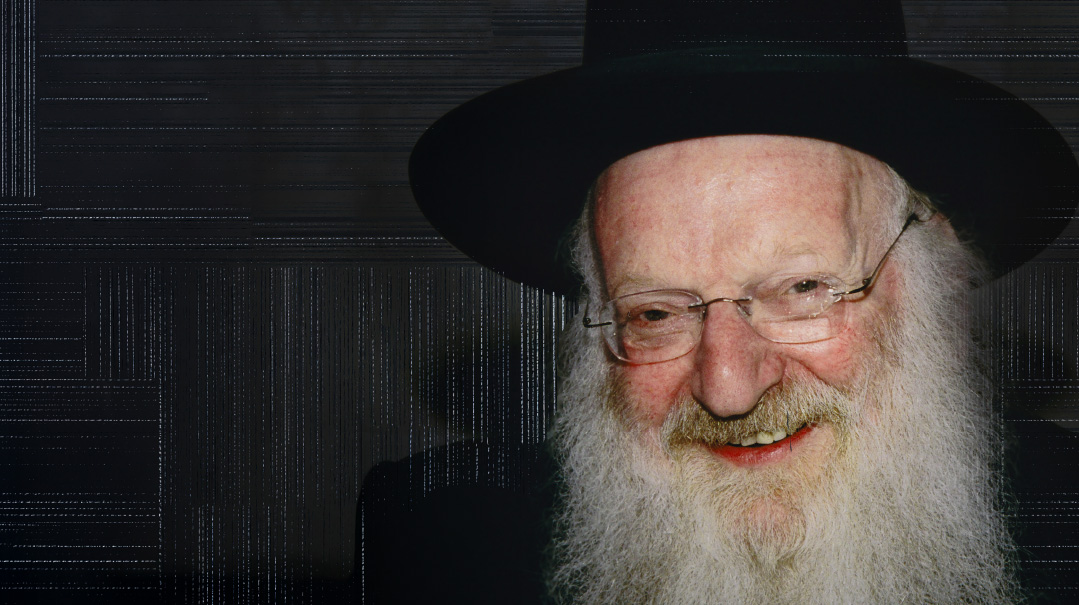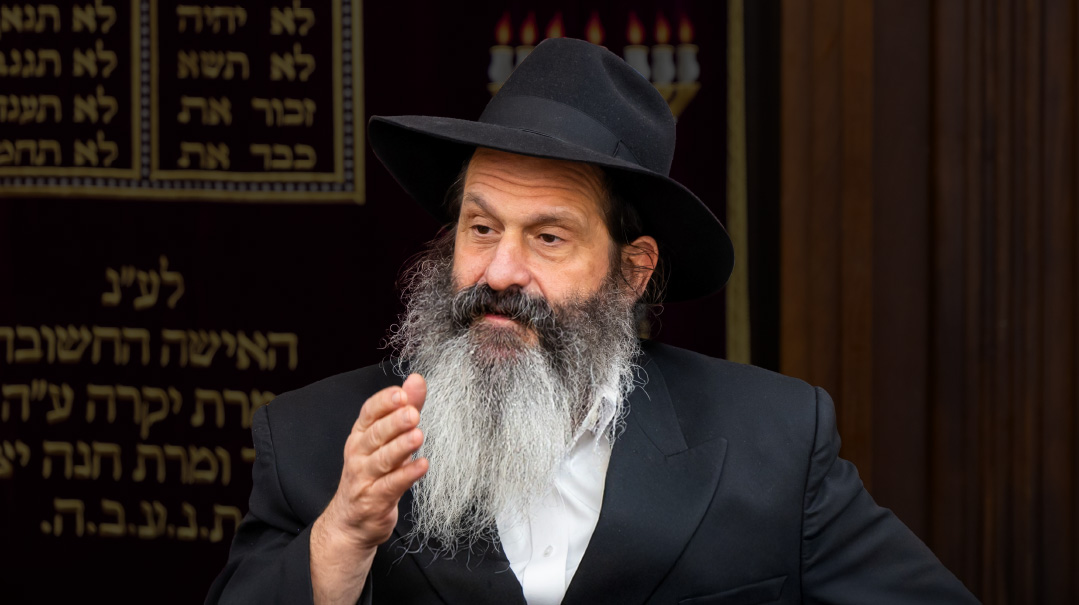Monsey’s Secret

Reb Shmelka Taubenfeld didn’t head a prestigious yeshivah or author best-selling seforim, but it was he who gave the entire chaburah its pride and prestige

We grace our walls with images of gedolim, men who shaped future leaders, wrote famous tomes, inspired and taught the masses. Rav Shmuel Shmelka Taubenfeld was a different kind of gadol: He lived in relative isolation, far from the public eye, and his only pursuit was Torah — more and more learning. But the people he touched, while relatively few, will forever carry his memory.
Walk up Monsey’s Route 306 where it intersects with Route 59 and savor the options: sushi or prime cuts of meat, upscale cafés or ice cream in a dazzling array of flavors. You can turn right, left, or go straight in Monsey, a capital of contemporary heimeshe gastronomy.
Sixty years ago, this very intersection was already a capital. Back then, it also featured diversity, breadth, and range, an incredible assortment of options, though not of the edible sort. Food was fairly limited — fresh baked goods imported from Brooklyn — but the tiny settlement boasted an assortment of unique gaonim. And like a gleaming display case in an epicurean heaven, it featured all sorts of scholars: some proficient in all of Shas, others capable of hairsplitting analysis. The penetrating self-awareness of Reb Yerucham’s mussar fused with the crackling warmth of Reb Shraga Feivel’s chassidus; there was room for everything in the display case that was the humble beis medrash of Beth Medrash Elyon, breeding ground of gedolim.
If you slip through the trees of Main Street, between the rustling leaves of Elyon Court, you can still see the old building, the rocks upon which Reb Shraga Feivel sat, talmidim at his feet, and shared mysteries of creation, the humble bungalows from which the first generation of kollel couples in America taught those that would yet come what the lifestyle demands.
And with a bit of imagination you might discern the impression left by a unique figure, humble in stature, carriage, and title while towering in genius and kindness.
Reb Shmelka Taubenfeld didn’t head a prestigious yeshivah or author best-selling seforim, but it was he who gave the entire chaburah its pride and prestige. His story, largely untold, is the coming-of-age tale of the American Torah world.
KELM IN ROCKLAND COUNTY
After Reb Shraga Feivel Mendlowitz’s Torah Vodaath succeeded in producing the bnei Torah that would give America its first generation of balabatim, the visionary menahel perceived the need for a higher level yeshivah, where the elite talmidim could continue on and give America maggidei shiur, dayanim, and rabbanim.
He purchased an estate in idyllic Monsey, far from the distractions and noise of the city, for this purpose. The staff he selected reflected his own breadth, his vision for the talmidim of this high-level institution. Rav Reuven Grozovsky, son in law and confidante of Rav Baruch Ber of Kamenitz, delivered the main shiur. Rav Yisrael Chaim Kaplan, son-in-law of Rav Yerucham Levovitz, delivered shiur and also served as mashgiach. This tapestry was woven together with the rich threads of Torah Vodaath’s most accomplished alumnus: Rav Gedalia Schorr, talmid of Rav Aharon Kotler’s Kletzk, chassid of Sadiger, and disciple of the chassidic schools of the Sfas Emes’s Ger and Reb Tzadok’s Lublin, served as menahel and gave the yeshivah its spirit.
Each individual talmid, about 40 in all, the choicest young men of the American yeshivah world, found a well from which to drink between the towering maple trees. The talmidim of Beth Medrash Elyon were as much a story as their rebbeim: boys from the streets of Brownsville or the Lower East Side who could rival their prewar counterparts.
At the Monsey dining room table of Reb Yeshaya Dovid Waxman, I hear a recollection. “My roommate was Rav Moshe Green. Today he’s a big rosh yeshivah, but then he was a just a boy from East New York. He liked to learn late, and when he came into the room, the others were often sleeping. He wanted to recite a lengthy Krias Shema, but he would never have done it on the cheshbon of others, so he would go back out into the hall and say his Shema, the way he wanted to.
“The middos in that yeshivah were like in Kelm.”
It wasn’t just the bochurim; the elevated atmosphere affected the employees as well; perhaps it was even spawned by them. There were the Apfledorfers, the couple who cooked for the bochurim. Of them, Rav Yaakov Kamenetsky said that it would we be worth it to attend the yeshivah simply to witness their chesed. After losing his spouse and children in the war, Reb Leib Apfeldorfer remarried a fellow survivor: they had no children of their own, but together, they decided that the talmidim at the yeshivah would be their offspring. There was Johnson, the deaf custodian who did his work with dignity and pride, perceiving, on some level, just how lofty a calling it was. There is a humorous tale they tell, the old-timers, about the mashgiach, Reb Yisrael Chaim, who, totally immersed in his spiritual pursuits, never really understood America.
The Mashgiach noticed a huddle of bochurim in conversation, and he approached, wondering what they were discussing with such emotion. “Kennedy was shot,” one of the talmidim said, filling him in.
The Mashgiach digested the information. “And who is president now?” he asked.
“Johnson has succeed him,” the bochur explained.
“Johnson!” exclaimed the holy Mashgiach, certain they were referring to the only one he knew with that name. “Why, I saw him not ten minutes ago. Amazing!”
LIFE ITSELF
Shabbos in yeshivah was the climax of the week. The bochurim would sing, and then, after the seudah, they would hurry back to the beis medrash. No one perused the weekly sedrah; Leil Shabbos was an intense learning seder, preparing for the shiur to be held the next day.
There were no waiters: the bochurim filled that role willingly.
At each seudah, someone would ask a kushya to his tablemates, the conversation at least as essential as the nutrients. Sometimes there was a satisfactory answer, other times there wasn’t: It made no difference. It wasn’t about answers but life itself.
The hasmadah reflected the urgency of that call. Rav Tzvi Elimelech Waxman, today a rav and rosh kollel in Monsey, but back then the executive director of the kollel, recalls just how serious each moment was. “No one had any money, but the yungeleit, who knew how hard we worked to meet payroll, would sometimes donate back some of their meager paychecks to the kollel. There was a gaon in yeshivah, Reb Leizer Lauer, who would give me $3.42, or $4.78, always a random number. I once asked him about this strange minhag; if it was maaser, why not give a proper round number? He explained that this wasn’t maaser; rather, he’d figured out the ratio of hours to dollars each month. Then, he deducted the proportionate amount for each minute he’d wasted, if he’d stepped out of the beis medrash.”
About the job itself, Reb Hershel, as he’s known, shares a tidbit. He was on his way to a career in chinuch when, discerning his organizational abilities and resourcefulness, the roshei yeshivah asked him to join the administration of the kollel.
“But I didn’t want to be a fund-raiser, and I let them know it. So Reb Reuven showed me a gemara about the value of talmud Torah of the rabbim, the public benefit, and he told me, ‘You will have the zechus of supporting yungeleit who will each have their own yeshivos one day.” (Rav Simcha Schustal, Rav Don Ungarisher, Rav Moshe Dovid Steinwurzel, Rav Mottel Weinberg, and Rav Yaakov Moshe Kulefsky, among others, would occupy places of distinction on the eastern wall of the American Torah world.) There were the Yamim Noraim in Beth Medrash Elyon, the sublime tefillos of Reb Hershel Mashinsky and Rav Simcha Schustal, the transcendent tekias shofar of Rav Yaakov Moshe Kulefsky. A half century later, their sounds are still seared onto the souls of those privileged to have been there.
WE NEED OUR LIONS
The story is told that when Rav Yitzchok Hutner assumed the leadership of Yeshivas Rabbeinu Chaim Berlin, Rav Shraga Feivel sent him a group of capable young scholars, the nucleus upon which Rav Hutner’s yeshivah would flourish. The board of directors at Torah Vodaath was upset, but Reb Shraga Feivel insisted he had acted correctly. “I don’t work for Torah Vodaath, but for Hashem. He made me a menahel and I need to do what’s best for Him.”
“Okay then,” one of the balabatim challenged Reb Shraga Feivel, “why not send Ungarisher and Schustal there as well?”
Reb Shraga Feivel smiled. “Because our yeshivah isn’t less deserving than any of the others; we also need our lions.” Don Ungarisher and Simcha Schustal — according to many, the two catalysts for Reb Shraga Feivel’s creation of the elite yeshivah in Monsey — were not alone, there were many others. There was a small chaburah of yungeleit that would have illuminated the world, had they only lived, people like Rav Moshe Dovid Steinwurzel, Rav Leizer Lauer, Rav Hirsch Goldwurm….
And even in that select group, Reb Shmelka stood tall….
AN ILUY HAS ARRIVED
Shmelke Taubenfeld arrived in America in 1949, seemingly a finished product, proficient in Shas, poskim, and Midrash. But when had he had time to learn? He’d attended cheder in his native Yaroslav, but by the time he reached his teens in the early 1940s, he was on the run from the Nazis, eventually ending up in freezing Siberia, a place barren of life, certainly of seforim.
In later years, Reb Shmelke once related how his childhood melamed would come to him each Siberian night in a dream and learn with him. One freezing night, he grasped how strange it was — a melamed who’d already passed away coming to teach him — and after that, the melamed stopped coming.
Oops! We could not locate your form.






